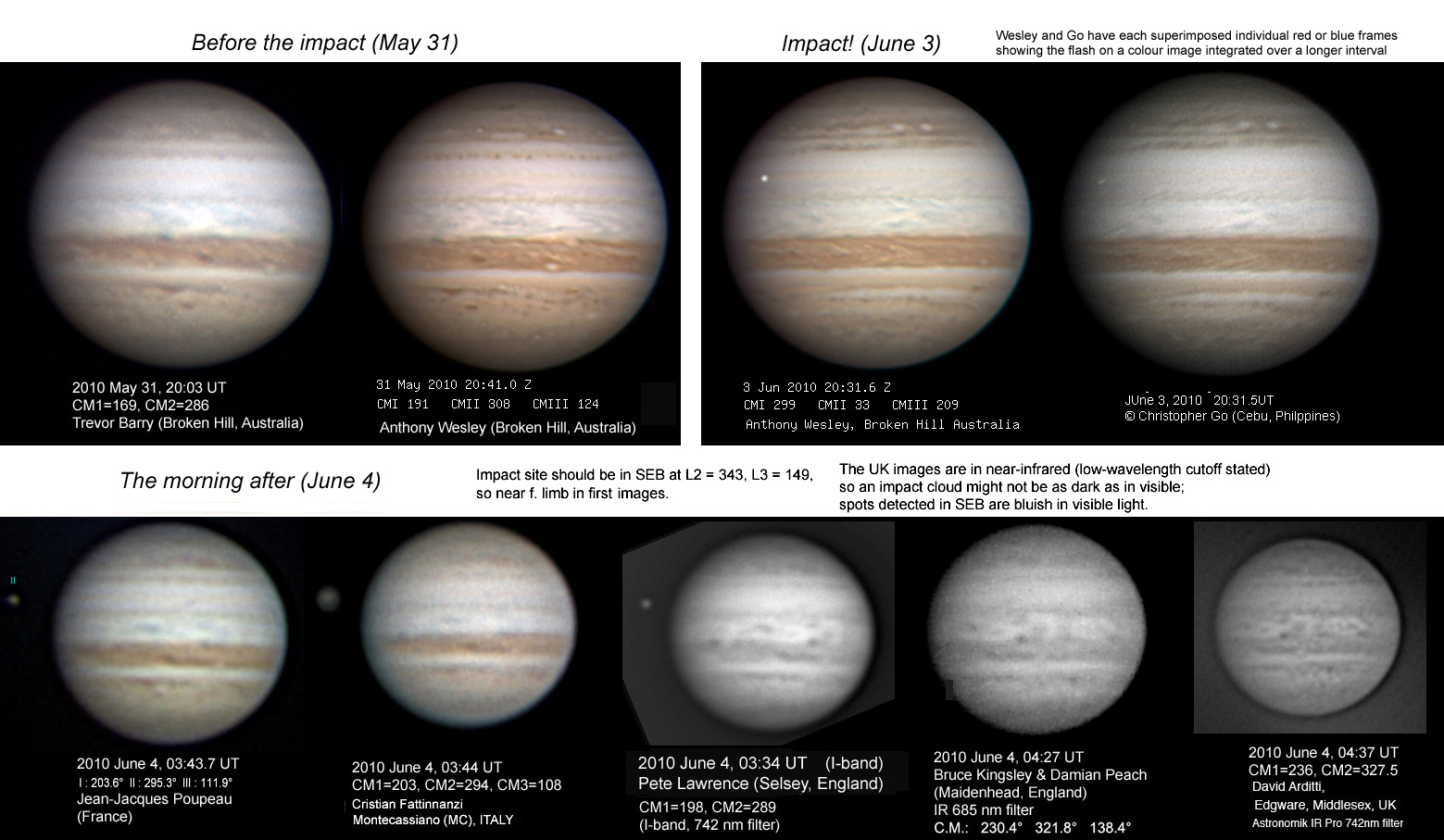| New impact on Jupiter before & after by John H.Rogers |
Hi everyone,
In case you have not been able to keep up with events overnight, here is a summary about the new impact on Jupiter.
The following BAA e-bulletin has just been issued (BAA members, it may take 24 hrs to reach you!)--
~~~~~~~~~~~~~~~~
A new impact has been detected on Jupiter. This time the impact flash was recorded directly, by two independent amateur observers. It was first reported by Anthony Wesley (Australia) (who discovered the impact last year), and confirmed by Chris Go in a video taken at exactly the same time: 2010 June 3, 20:31:29UTC. It was a very bright flash lasting about 2 seconds, so there can be no doubt that it was an impact; no internal event in Jupiter would produce such a bright brief flash.
It was in the faded South Equatorial Belt, about 50 deg. preceding the central meridian; Wesley's preliminary measurements put it at Longitude L2 = 342.7, L3 = 159.4, Latitude 16.1 deg.S.
Nothing further was seen at the impact site in the half-hour before it disappeared round the limb. When it reappeared, this morning around 03:30 UT , observers in England, France and Italy looked for an impact spot but recorded nothing definite. However, the images were at low resolution (due to the low altitude and bright dawn sky), so the images do not exclude a smaller scar. Observations of this site over the next few days will be very important.
Even if no 'scar' is detected, this would not be surprising. The direct imaging of the SL9 impacts in 1994 by the Galileo spacecraft showed a bright flash a few seconds long like this one even for a small fragment which produced virtually no scar, probably because a small impactor can explode high in the atmosphere. So, impacts like this could be frequent, but never before recorded, and still consistent with the rarity of larger impacts that leave obvious traces.
By the way: Uranus is 0.5 degrees north of Jupiter at present: a good opportunity to compare the two giant planets.
~~~~~~~~~~~
Images taken before, during and after the impact are attached. Note that there are a few faint blue-grey spots in this region of the SEB, which show up dark in the infrared images; these are not impact-related. Thanks to Pete Lawrence, Bruce Kingsley with Damian Peach, David Arditti, Cristian Fattinnanzi, Jean-Jacques Poupeau, & Fabio Carvalho (similar IR image just posted), for this morning's images. Did Spanish observers get anything?
Anthony and Chris are posting images and videos on their web sites, and a resume was given in a news bulletin already:
http://arstechnica.com/science/news/2010/06/breaking-news-jupiter-hit-by-yet-another-impactor.ars
If this is indeed a small impact which doesn't leave a scar, I wonder if they have ever been seen before. This is the first direct ground-based observation of an impact fireball on any planet that I know of. Old-time visual observers would perhaps never have mentioned such a flash as it could not be recorded nor confirmed. This time both Anthony and Chris were recording routine videos to produce images, and caught it. Regular imagers: how many minutes/hours per night do you typically record? Do you look thru all of it??
Whether or not there is a scar, this is a very important observation, and from Anthony's and Chris's videos it should be possible to measure the light-curve, and compare it with those of the SL9 fragments from Galileo. Also, Chris points out that his video may show an elongated entry track and further structure. A fantastic achievement by both of them!
best wishes,
John

John H. Rogers,Ph.D.
Jupiter Section Director,
[British Astronomical Association.]
●木星の新たな衝突 皆さんへ、 一晩中イベントに付き合っていられなかった人のために、木星の新たな衝突に ついてサマリーを作成した。 以下のBAA電子会報がちょうど発行された(BAAメンバーには24時間で届くだろう)。 木星に新たな衝突が検出された。今回は、二人の独立したアマチュア観測者に よって、直接に衝突の閃光が記録された。最初にAnthony Wesley(オーストラリア) 【昨年衝突を発見した】が報告し、Chris Goによって正確に同じ時刻2010年6月3日 20:31:29UTCに撮影されたビデオで確認された。約2秒間継続した非常に輝く閃光で あったので、これは衝突であることに疑いがない。木星内部の現象はこのような 輝く短時間の閃光を生み出さない。 これは淡化したSEBの中央経度から約50度前方にあり、Wesleyの初期的計測では 経度はL2=342.7度、L3=159.4度、緯度は南緯16.1度である。 衝突サイトには、リムで見えなく前の半時間で何も見えなかった。再び現れたのは 今朝の03:30UT頃で、イギリス・フランス・イタリアの観測者が衝突斑点を探したが、 明確なものは何も記録されなかった。しかしながら、画像は低解像度で(低い高度と 明るい夜明け空のため)、画像では小さな痕跡を除外することができない。数日間の このサイトの観測はとても重要になるだろう。 痕跡が検出されなかったとしても、それは驚くことではない。ガリレオ探査機による 1994年のSL9衝突の直接撮影によって、実際に痕跡ができなかった小さなフラグ メントでさえ、今回のような数秒間の輝く閃光が見られたが、たぶん小さな衝突物は 大気高層で爆発するからだろう。さて、今回のような衝突は頻繁に起こっているかも しれないが、記録されたものより前には決して見られなかったことで、明らかな跡を 残すような大きな衝突の珍しさと一致している。 ところで、天王星が現在木星の北0.5度にいて、二つの巨大惑星を比較する良い 機会である。 ※衝突の前・中・後に撮影された画像を添付する。SEBのこの領域には、数個の 淡い青灰色の斑点があることに注目、それらは赤外画像で暗く見えるが、衝突とは 関係しない。今朝の画像について、Pete Lawrence, Bruce KingsleyとDamian Peach, David Arditti, Cristian Fattinnanzi, Jean-Jacques Poupeau, Fabio Carvalho(同様な 赤外が送られてきた)に感謝する。スペインの観測者はどうしている? AnthonyとChrisは彼らのwebサイトで画像やビデオを公開しているが、新しい会報で はすでに要約が出ている。 http://arstechnica.com/science/news/2010/06/breaking-news-jupiter-hit-by-yet-another-impactor.ars これが本当に痕跡を残さないような小さな衝突であるならば、これまでにも見られた と思われる。知る限りでは、これが他の惑星上に見られた衝突火球の地球からの 初めての直接観測である。昔の眼視観測者はおそらく記録も確認もできないような 閃光を決して言及していない。今回はAnthonyとChrisは画像を作成するためにルー チンのビデオを撮影していて、閃光をとらえた。正規の観測者へ、典型的に一夜で 何分あるいは何時間撮影するのか?その全てを見るのか? 痕跡が存在するのか、しないのかは、とても重要な観測である。また、Anthonyと Chrisのビデオから光度カーブを計測して、ガリレオからのSL9フラグメントのカーブ と比較できるだろう。また、Chrisは彼のビデオから長く伸びた入射路と複雑な構造が 見えるかもしれないと指摘している。彼ら二人による素晴らしい業績である。 John H. Rogers, Ph.D. Jupiter Section Director, British Astronomical Association. --- 伊賀祐一 (Yuichi Iga) 月惑星研究会関西支部
ALPO-Japan Latest
Jupiter Section